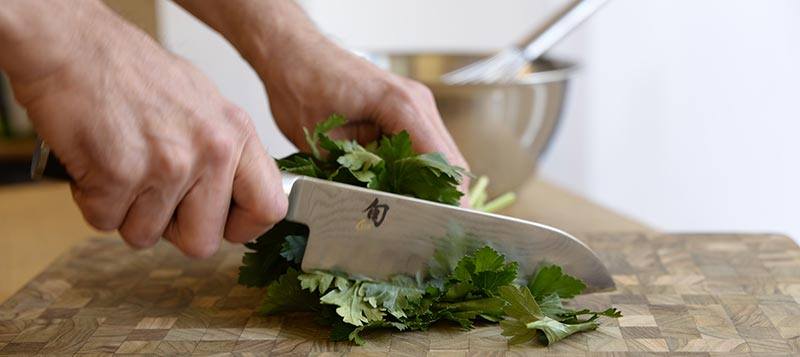Of all the things that make cooking less laborious, a sharp knife has to be up there. However, we’re no longer surprised when someone brings a knife in for sharpening (all of our stores offer this service) they haven’t sharpened a year or more ago since they bought it. Like many things, this is a matter of establishing a habit!
Although obscure methods may exist, for most, there are three ways to sharpen a knife…
Pull-through
This is the way forward if you’re happy getting your knife almost as sharp as it can possibly be and want something quick, easy and foolproof.
Advantages
• You are guaranteed to sharpen the edge of your knife at the perfect angle with no effort.
• Quick and easy – possible to sharpen mid-way through cooking, takes a minute.
Disadvantages
• If you want absolutely ultimate sharpness, this isn’t for you – you’ll need to invest the time and effort into using a whetstone. It’s the difference between a knife that’s lovely & sharp & great to cook with and ‘Woah… that’s… sharp!’
You do not need to apply downward force – just drag the knife through and let the pull-through gently sharpen.
For Minosharp sharpeners, fill the water reservoir first.
You will need the right pull-through for European (20° edge) and Japanese (15°) knives.
Whetstone
A whetstone is the way to go if you’re prepared to take the time and effort to get your knife as sharp as it can possibly be.
Advantages
• Will get the knife to the finest edge possible.
• Will correct any minor imperfections along the knife edge, rather than just following the shape like a pull-through or steel.
Disadvantages
Whetstones must be soaked to absorb water before sharpening; not a great solution if you’re mid-way through cooking and realise your knives need a sharpen.
How to sharpen a knife with a stone
• Hold the blade against the stone at the appropriate angle and push backwards and forwards, using a small amount of pressure. After 5-10 upward and downward movements, if it's a long blade, move the knife along and repeat until you have covered the length of the blade.
• The knife should make the same sound with each stroke. If it doesn’t, you’re not keeping the angle consistent.
• Powder will appear as you sharpen. The powder is a good thing – it helps sharpen the knife.
Sharpening steel
Advantages
• Technically not a sharpener as such, a steel is a great way of honing a knife. The edge of a knife can become blunt simply because tiny particles on the edge becomes bent – honing straightens these microscopic bends. This is something a chef would usually do before each service, and the steel is designed to be used frequently to keep the edge in line.
Disadvantages
• If the edge of the knife has actually become blunt, a standard sharpening steel will not sharpen the edge. For that, you will need a diamond steel, designed for sharpening rather than honing.
How to sharpen a knife with a steel
The easiest way to get the correct angle is to place the Steel tip-down on a work surface so it’s vertical. Then hold the knife tip against it so the knife’s at a horizontal (90°) angle. Halve the angle (90°) halve again (22°) and take a tiny bit off and you should be at the correct angle for European knives (20°). For Japanese knives, (10-15°), take a tiny bit more off.
Sharpen using a downward motion, alternating each side. Just the weight of the knife should be sufficient pressure.
As Japanese knives are sharpened to 10-15°, metal would be too coarse and would damage such a fine edge, so ceramic is usually used for honing Japanese knives.
How to sharpen a knife without a sharpener
If you don't own a sharpener, by all means bring your knives to one of our stores for sharpening. It usually takes between 1-2 days and costs between £4 to £6 per knife. And we'll happily talk you through the options should you wish to maintain your knives at home!
How to sharpen a Santoku knife
We get asked this a lot, but most of the standard rules (above) apply. If anything, sharpening a Santoku is easier, as the blade is straighter than a European chefs knife. The key thing to remember is, as ever, if it's a Japanese Santoku, the edge will need to be sharpened to a finer angle than a European knife.
How to sharpen serrated knives
Serrated knives typically need less sharpening than straight edged blades, as they drag and tear rather than cut in the conventional way. Should you want to sharpen your serrated knife, use a steel and, one by one, position it in the dip between each pair of blade points. Position it at the same angle as you see on the edge (this is often just one side), and pull towards you a few times. Repeat for each dip. We also offer a sharpening service for serrated knives in store.


Leave a comment